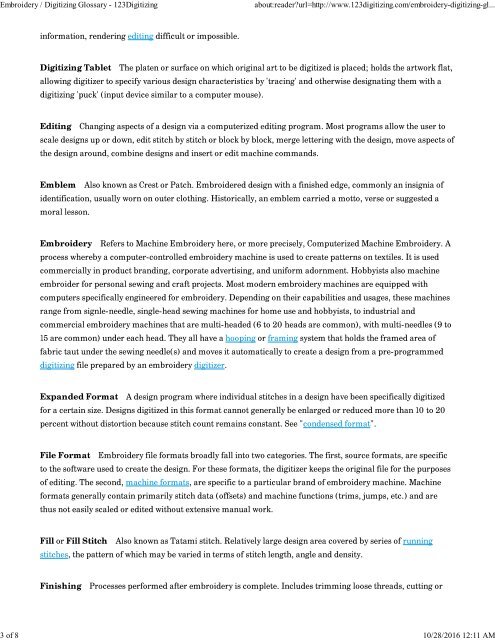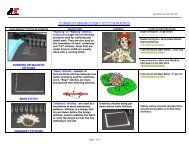Compiled Embroidery Skill Articles
Create successful ePaper yourself
Turn your PDF publications into a flip-book with our unique Google optimized e-Paper software.
<strong>Embroidery</strong> / Digitizing Glossary - 123Digitizing<br />
about:reader?url=http://www.123digitizing.com/embroidery-digitizing-gl...<br />
3 of 8 10/28/2016 12:11 AM<br />
information, rendering editing difficult or impossible.<br />
Digitizing Tablet The platen or surface on which original art to be digitized is placed; holds the artwork flat,<br />
allowing digitizer to specify various design characteristics by 'tracing' and otherwise designating them with a<br />
digitizing 'puck' (input device similar to a computer mouse).<br />
Editing Changing aspects of a design via a computerized editing program. Most programs allow the user to<br />
scale designs up or down, edit stitch by stitch or block by block, merge lettering with the design, move aspects of<br />
the design around, combine designs and insert or edit machine commands.<br />
Emblem Also known as Crest or Patch. Embroidered design with a finished edge, commonly an insignia of<br />
identification, usually worn on outer clothing. Historically, an emblem carried a motto, verse or suggested a<br />
moral lesson.<br />
<strong>Embroidery</strong> Refers to Machine <strong>Embroidery</strong> here, or more precisely, Computerized Machine <strong>Embroidery</strong>. A<br />
process whereby a computer-controlled embroidery machine is used to create patterns on textiles. It is used<br />
commercially in product branding, corporate advertising, and uniform adornment. Hobbyists also machine<br />
embroider for personal sewing and craft projects. Most modern embroidery machines are equipped with<br />
computers specifically engineered for embroidery. Depending on their capabilities and usages, these machines<br />
range from signle-needle, single-head sewing machines for home use and hobbyists, to industrial and<br />
commercial embroidery machines that are multi-headed (6 to 20 heads are common), with multi-needles (9 to<br />
15 are common) under each head. They all have a hooping or framing system that holds the framed area of<br />
fabric taut under the sewing needle(s) and moves it automatically to create a design from a pre-programmed<br />
digitizing file prepared by an embroidery digitizer.<br />
Expanded Format A design program where individual stitches in a design have been specifically digitized<br />
for a certain size. Designs digitized in this format cannot generally be enlarged or reduced more than 10 to 20<br />
percent without distortion because stitch count remains constant. See "condensed format".<br />
File Format <strong>Embroidery</strong> file formats broadly fall into two categories. The first, source formats, are specific<br />
to the software used to create the design. For these formats, the digitizer keeps the original file for the purposes<br />
of editing. The second, machine formats, are specific to a particular brand of embroidery machine. Machine<br />
formats generally contain primarily stitch data (offsets) and machine functions (trims, jumps, etc.) and are<br />
thus not easily scaled or edited without extensive manual work.<br />
Fill or Fill Stitch Also known as Tatami stitch. Relatively large design area covered by series of running<br />
stitches, the pattern of which may be varied in terms of stitch length, angle and density.<br />
Finishing Processes performed after embroidery is complete. Includes trimming loose threads, cutting or




